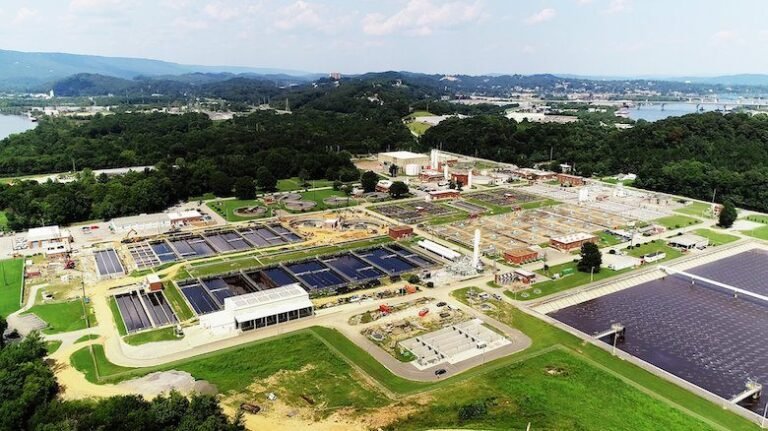
Archer Western and Stantec will lead Chattanooga, Tenn.’s effort to upgrade wastewater facilities at its Moccasin Bend Environmental Campus on the Tennessee River, including plans for the world’s largest membrane-aerated biofilm reactor.
The team will design and construct Phase 1 of a Class A Process Optimization Project for Energy Recovery from Wastewater (POWER) and on-site wastewater treatment plant upgrades, where the city has installed infrastructure to support energy, water and cost savings, including solar electricity generation. . Archer Western Construction will be the main contractor for the project, with Stantec leading design and engineering. The facility is expected to become operational in December 2028.
In an announcement, Stantec and Archer Western say the progressive design-build project is expected to include a thermal hydrolysis process (THP) facility, anaerobic digestion upgrades and a facility conversion of high-purity oxygen in a membrane-aerated biofilm reactor (MABR).
Waste-to-energy systems convert organic solids from wastewater into biogas, which is used on-site to power operations and to be processed and sold as a substitute for natural gas.
Once completed, according to the announcement, the facility will be the world’s largest MABR facility, described as an energy-efficient, intensified nutrient removal process that will allow Chattanooga to use existing tanks while meeting future nutrient limits in effluents discharged from the Moccasin Bend site. .
It will produce Class A biosolids that can be used as a soil additive on nearby farms, and biogas that will be reused to generate steam, with excess generating power for the facility.
To meet the city’s operational and sustainability goals, the biosolids portion will integrate the THP facility into the existing biosolids treatment process, improving anaerobic digestion and biogas production while reducing the volume of biosolids by to the removal.
The project was introduced in September 2023 at a meeting of the city’s Industrial Development Board, with Mark Heinzer, Chattanooga’s wastewater administrator, telling the board the project could cost between $130 million and $150 million. of dollars
He said the city currently hauls up to 15 truckloads a day of Class B biosolids, which must be hauled at least 50 miles away for application.
According to the minutes of that meeting, 49 percent of the project is being funded through a $186 million federal Water Infrastructure Innovation and Financing Act (WIFIA) loan passed in 2022 that it is also divided between three other projects, with a December 31. Term 2028.
Heinzer told the board that the leftover gas can be put back into the grid for renewable energy credits or can power vehicles, expecting $4 million a year in the sale of renewable energy credits. In all, he said it represents up to $9 million in annual savings for the city.
Chattanooga Mayor Tim Kelly said in a statement afterward that the facility upgrade will help the city decentralize its renewable energy generation efforts and double the efficiency of its wastewater system to better address continued growth in the region.
Parts of the city’s wastewater infrastructure system are reaching the end of their useful lives, the city says, contributing to failures during heavy rains and sewer overflows.
The project is part of the city’s Clear Chattanooga effort, a community-wide plan to reduce the number of sewer overflows to meet an April 2013 consent decree agreement with the Clean Water Network of the EPA, the state of Tennessee and Tennessee after a lawsuit alleging the city had violated the Clean Water Act.
The consent decree agreement includes Chattanooga’s commitment to spend $784 million on a multi-year program that includes major upgrades, system overhauls, pipe replacement and more.
Chattanooga has completed assessments of 1.3 million feet of pipe, leading to the replacement or rehabilitation of 300,000 feet to date, and constructed three equalization stations to temporarily store overflow wastewater, adding capacity of 30 million gallons in the system.

